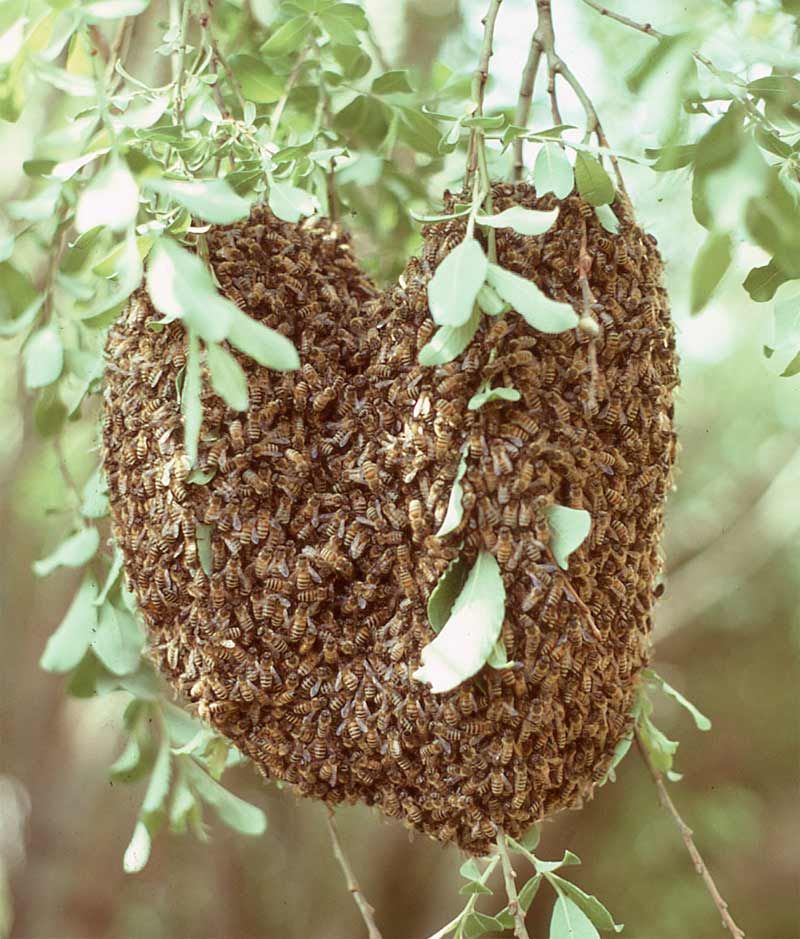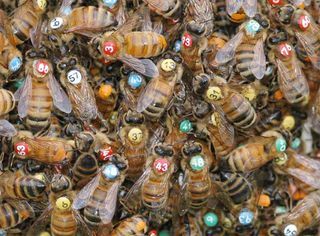Head Butts & Waggle Dances: How Honeybees Make Decisions

Honeybees choose new nest sites by essentially head-butting each other into a consensus, shows a new study.
When scout bees find a new potential home, they do a waggle dance to broadcast to other scout bees where the nest is and how suitable it is for the swarm. The nest with the most support in the end becomes the swarm’s new home.
But new research shows another layer of complexity to the decision-making process: The bees deliver "stop signals" via head butts to scouts favoring a different site. With enough head butts, a scout bee will stop its dance, decreasing the apparent support for that particular nest.
This process of excitation (waggle dances) and inhibition (head butts) in the bee swarm parallels how a complex brain makes decisions using neurons, the researchers say.
"Other studies have suggested that there could be a close relationship between collective decision-making in a swarm of bees and the brain," said Iain Couzin, an evolutionary biologist at Princeton University, who was not involved in the study. "But this [study] takes it to a new level by showing that a fundamental process that's very important in human decision-making is similarly important to honeybee decision-making."
Head-butting honeybees
When honeybees outgrow their hive, several thousand workers leave the nest with their mother queen to establish a new colony. A few hundred of the oldest, most experienced bees, called scout bees, fly out to find that new nest.
Sign up for the Live Science daily newsletter now
Get the world’s most fascinating discoveries delivered straight to your inbox.
"They then run a popularity contest with a dance party," said Thomas Seeley, a biologist at Cornell University and lead author of the new study. When a scout bee finds a potential nest site, it advertizes the site with a waggle dance, which points other scouts to the nest’s location. The bees carefully adjust how long they dance based on the quality of the site. "We thought it was just a race to see which group of scout bees could attract a threshold number of bees," Seeley told LiveScience. [Bees Form Better Democracy]
But in 2009, Seeley learned that there might be more to the story. He discovered that a bee could produce a stop-dancing signal by butting its head against a dancer and making a soft beep sound with a flight muscle. An accumulation of these head butts would eventually cause the bee to stop dancing. Seeley observed that the colony used these stop signals to reduce the number of bees recruited to forage from a perilous food source, but he wondered if the bees also used the head butts during nest hunting.
To find out, Seeley and his colleagues took honeybee swarms to Appledore Island in Maine, a treeless island with no natural nest sites, and observed how the bees chose from among the researchers' man-made nests. For each trial, they placed two identical nest boxes at equal distances from a swarm. When a scout would investigate a nest, the researchers painted a pink or yellow dot on the bee — this allowed them to quickly surmise which nest the scout was advertising back at the swarm.

They saw that after dancing for a while, a scout bee would take a break to walk around the swarm. She would then deliver a stop signal to another dancing bee, but only if that bee had checked out the opposite nest. "It turns out that they are quite discriminating," Seeley said. "That's pretty sophisticated."
The bees collectively chose a nest site when one of the nests accumulated 50 to 100 dancers, so the head-butting could help determine which site got enough waggling support. After that, the scouts changed their stop-signal tactics and began head-butting any bee that was still dancing, because the swarm had already reached a consensus.
With a computer model, the researchers learned that this discriminating inhibition is vital to bee decision-making. Without the signals, the bees would likely reach a stalemate when posed with equally suitable nests.
Understanding the brain
Couzin is curious to see if a similar inhibition mechanism exists in other animals that live in groups, such as flocking birds and schooling fish. "And I think it would be extremely interesting to look for it in other social insects," such as ants, Couzin said.
A critical aspect in our ability to make choices is neural inhibition, where neurons actively suppress the activity of other neurons, much like how the honeybees use their stop signals. Couzin thinks that further research into social insects decision-making may help us better understand our own decision processes.
Unlike the human brain, "one of the beautiful things about looking at social insects is that you can really see the individual components and really determine the mechanisms involved,” Couzin said.
The study was published online Dec. 8 by the journal Science.
Follow LiveScience for the latest in science news and discoveries on Twitter @livescience and on Facebook.
